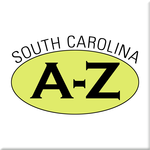South Carolina from A to Z
We retired this podcast, because we couldn't parse it for 10 consecutive times.

- Website
- http://southcarolinapublicradio.org/programs/south-carolina-z
- Description
- Historian and author Walter Edgar mines the riches of the South Carolina Encyclopedia to bring you South Carolina from A to Z. Produced by South Carolina Public Radio.
- Language
- 🇬🇧 English
- last modified
- 2021-03-16 16:45
- last episode published
- 2021-03-16 09:30
- publication frequency
- 1.64 days
- Contributors
- Alfred Turner
- Author
- South Carolina Public Radio
- Owner
- Explicit
- false
- Number of Episodes
- 889
- Rss-Feeds
- Detail page
- Categories
- Society & Culture History
Recommendations
Episodes
| Date | Title & Description | Contributors |
|---|---|---|
| 2021-03-16 | "T" is for Taxpayers’ Conventions (1871, 1874). In 1871 and 1874 white Democrats in South Carolina, frustrated with high taxes and the Republicans’ domination of state government, held statewide conventions to register their protests. The 1871 conventi... |
|
| 2021-03-15 | "S" is for St. George’s Dorchester Parish. The Commons House created St. George’s Dorchester Parish on December 11, 1717. The new parish was previously part of St. Andrew’s Parish and was created to accommodate the growing number of colonists along the... |
|
| 2021-03-11 | "R" is for Ramsay, David (1749-1815). Physician, legislator, historian. A native of Pennsylvania, Ramsay graduated from Princeton and studied medicine at the College of Philadelphia. He moved to Charleston in 1773 where he soon became involved in local... |
|
| 2021-03-10 | "P is for Palmetto Armory. The Palmetto Armory was a short-lived effort to establish a weapons-manufacturing capability in South Carolina during the secession crisis of 1849-1852. In 1850 the General Assembly created a Board of Ordnance and appropriate... |
|
| 2021-03-09 | “O” is for Okra. Also known as lady’s fingers, gombo, gumbs, quingombo, okro, ochro, bamia, and quiabo, okra is considered by southerners to be a delicacy, in spite of its slippery quality. The poet James Dickey once avowed, “If God had made anything b... |
|
| 2021-03-08 | “N” is for National Beta Club. The National Beta Club was founded January 8, 1934 at Landrum High School by Dr. John West Harris, faculty member at Wofford College. Reared on a farm and aware of the privations of his day, Harris worked to develop youth... |
|
| 2021-02-05 | "H" is for Hamburg. Founded in 1821 and located on the Savannah River in lower Edgefield District, the town of Hamburg was one of South Carolina’s primary interior markets during much of the antebellum era. The town grew rapidly after it became the wes... |
|
| 2021-02-04 | "G" is for Gaillard, John (1765-1826). U.S. senator. A native South Carolinian, Gaillard went to England with his family during the American Revolution. He studied law, but opted to return to South Carolina and become a planter. From 1794-1804 he repre... |
|
| 2021-02-03 | "F" is for Farrow, Samuel (1759-1824). Congressman, legislator, reformer. Born in Virginia, Farrow’s family moved to South Carolina in the 1760s. Although he had little formal education, he had a successful career as a lawyer. Farrow was elected lieute... |
|
| 2021-02-02 | "E" is for Earthquakes. Earthquakes (seismic events) have had an impact on South Carolina for thousands of years. The state’s earthquakes have been tectonic; that is, they have resulted from intraplate displacements on the North American plate and not ... |
|